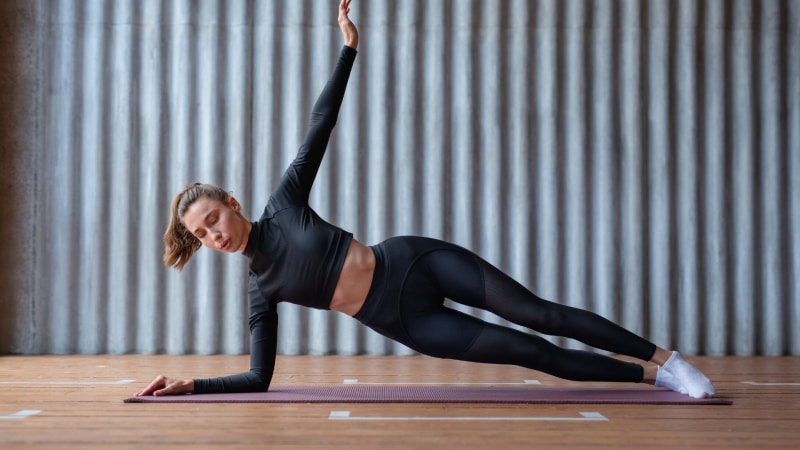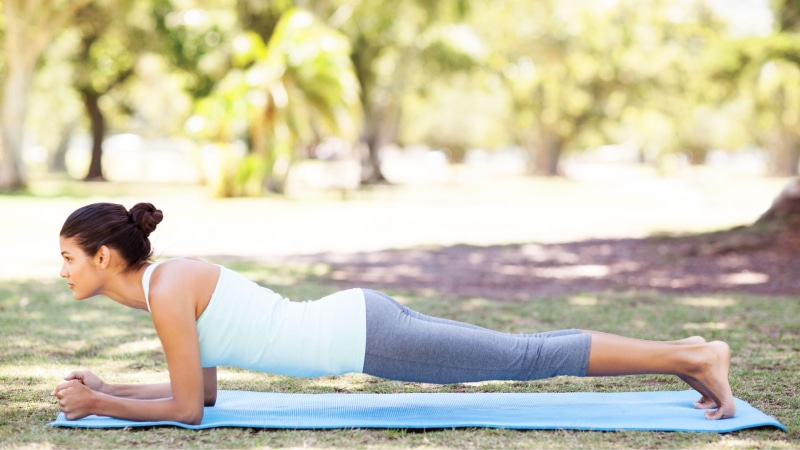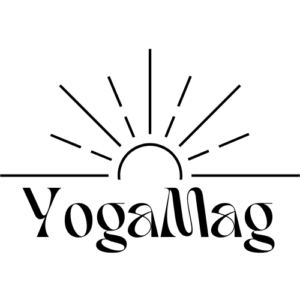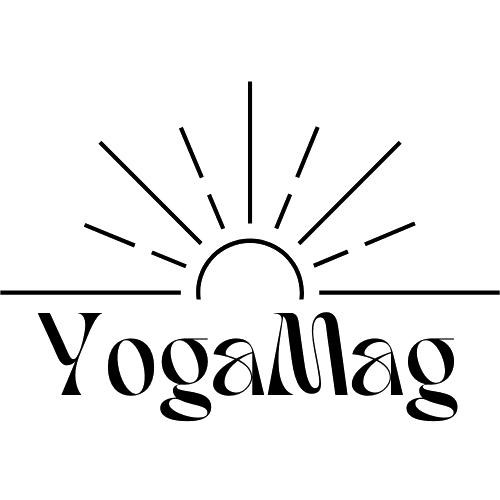The plank, also known as the plank exercise, is gaining recognition as one of the most effective abdominal exercises that can be performed anywhere. But do you know what the real plank effects are and what muscles are involved when performing it? Dive into the world of the plank and discover how this simple yet challenging exercise can transform your body and improve your muscular endurance.
Plank – results after a simple exercise
While the plank may seem like a simple exercise at first glance, it hides a profound complexity and offers an impressive array of benefits for the entire body. Also known as a plank exercise, the plank engages not only the abdominal muscles, but works multiple muscle parts, providing a comprehensive workout with minimal risk of injury. But what are the specific plank effects and why should you include this exercise in your routine?
The basic plank mainly engages the abdominal muscles, but also the muscles of the hips, legs, arms and back. Plank what muscles work? The answer may surprise you! When holding the body in the plank position, the extensor muscles of the spine, gluteal muscles, arm and leg muscles, as well as the deep abdominal muscles work. This makes the plank not only an excellent abdominal exercise, but also a versatile workout that strengthens various parts of the body.
It is also worth noting that regular performance of the plank can bring a number of health and functional benefits. Improving posture, increasing muscular endurance, reducing back pain, or even improving balance and coordination are just some of them. It is also worth mentioning that plank is an excellent exercise at home, it requires no specialized equipment and can be performed in the comfort of your own home.
Although the plank is often perceived as a static exercise, it is worth remembering its various variations that can provide additional benefits and add variety to your workout. For example, the side plank, which particularly engages the lateral abdominal muscles, providing an additional challenge and helping to build strength in this part of the body.
In a practical context, it’s also worth considering how long and how often you should perform the plank. Plank how many series and how long to hold the position for optimal results? Experts often recommend starting with short intervals, even from 20-30 seconds, gradually increasing the time of holding the position, as well as the number of series, adapting the training to your own abilities and goals.
Side plank – exercises in different variations
While the classic plank is a great starting point for anyone looking to strengthen their body, it’s also worth diving into the world of different variations of this exercise to tailor the workout to your individual needs and goals. Different variations of the plank can provide additional benefits, engaging different muscle groups and providing new challenges to help you develop your strength and endurance.
For example, the side plank is a great way to engage the lateral abdominal muscles while offering a challenge to your body’s balance and stability. Performing this variant with additional movements, such as leg or arm raises, can further increase the intensity of the exercise and provide additional benefits to your training.
Also worth mentioning is the forearm version of the planck, which is often recommended for people who experience wrist pain during the classic planck. This version of the exercise can also provide an additional challenge for your abdominal muscles, requiring them to do extra work while maintaining a stable position.
If you’re looking for something that will further engage your legs and glutes, it’s worth trying the planck with leg raises. This variant not only provides an extra challenge for your abdominal muscles, but also does a great job on your leg and buttock muscles, helping to shape and strengthen these body parts.
In the context of customizing the planck, it’s also worth mentioning that this exercise can be modified to make it accessible to people at different fitness levels. For example, people who are new to the planck can start with a version of the exercise on their knees, gradually moving to the full version of the planck when their strength and endurance are at the right level.

The plank challenge – how to do it right?
Performing the plank with apparent ease can lead to the certainty that this is an exercise that does not require special attention. Nothing could be further from the truth. The plank, despite its simplicity, is often a source of mistakes that can not only negate its effectiveness, but also lead to potential injury. So how do you make sure your plank exercise is performed correctly and safely?
The first and most common mistake is incorrect body alignment. Your body should form a straight line from head to heels, meaning your head, hips and ankles should be in line. Avoid lifting the hips too high or letting them drop – both mistakes can lead to excessive strain on the lower back and reduce the effectiveness of the exercise.
Another mistake is improper positioning of the hands or elbows. In a classic planck on the hands, the hands should be positioned directly under the shoulders to provide adequate support and stability. In forearm planck, the elbows should be placed directly under the shoulders and the forearms parallel to each other to avoid unnecessary stress on the joints.
It’s also worth paying attention to breathing while performing planku. Often, while holding the position, people forget to breathe properly and deeply, which is crucial for maintaining stability and muscular endurance during the exercise. Remember to breathe deeply and evenly throughout the exercise.
Although planking how many series and how long to perform the exercise is an individual matter, it is important to remember to listen to your body. If you experience pain or discomfort while planking, it’s worth checking your form and adjusting the exercise to make it safe and comfortable for you.
Plank – exercises tailored to your capabilities
Theplank, despite being a universal exercise, can be performed in a variety of ways, tailored to each person’s individual needs and abilities. Whether you are a beginner or an advanced athlete, plank can be customized to meet your expectations and help you achieve your training goals.
Those who are new to the plank can benefit from modifications that will make the exercise more accessible and beginner-friendly. For example, the lap plank is a great way to start working on building core strength, while allowing you to avoid overexertion and maintain proper form.
For those looking for an extra challenge, there are many advanced variations of the plank that can help further build strength and endurance. For example, a leg or arm lift plank, a pivot plank or even a single-leg or single-arm plank can provide additional load and help you push your limits.
It is also worth mentioning the importance of progression in plank training. Plank how many series and how long should you hold the position to achieve the best results? The key is to gradually increase the duration of the exercise and the number of series, rather than aiming to hold the position as long as possible from the start. Remember that regularity and consistency are key to achieving lasting results and avoiding injury.

Plank – 30 days. Introduce plank into your daily routine
Introducing the plank into your daily exercise routine can be the key to building core strength, improving posture and achieving a range of other health benefits. But how do you integrate this versatile plank exercise into your schedule to maximize its plank effects and make it a permanent part of your lifestyle?
First of all, it’s worth noting that plank is an extremely flexible exercise in terms of time and space. It doesn’t require a lot of space or specialized equipment, making it an ideal choice for exercising at home or as an addition to your workout routine at the gym. You can perform the plank anywhere and anytime, making it one of the most accessible exercises you can choose.
When it comes to duration and frequency, it’s worth remembering that even short sessions of plank can bring significant benefits. Even a few minutes spent exercising each day can lead to improvements in core strength and stability. The key is consistency and regularity, so find a time that works for you – whether it’s in the morning to activate your muscles for the day, or in the evening as part of your routine before bed. If you perform the plank every day for 30 days, you’ll see significant results!
You should also consider integrating the plank with other abdominal and general exercises to provide a comprehensive workout and work on different aspects of your fitness. For example, combining plank with mobility, strength and endurance exercises can help you build a comprehensive training plan that will help you achieve your health and fitness goals.
Summary: Plank exercise that will transform your body
The plank, or popular plank exercise, is not only accessible and feasible for everyone, but also offers an impressive array of health and functional benefits. From building muscular strength and endurance to improving posture and supporting daily activities, plank is a versatile exercise that can bring significant plank effects to your life.
Check also: Why is it so important to learn to enjoy sports?
Plank – the most frequently asked questions
Two minutes of plank can be a challenge for many people, especially those who are new to the exercise. However, for a person with good fitness and muscular endurance, it can be an achievable goal.
The duration of the plank should be tailored to the individual fitness and endurance of the exerciser. For beginners, it can be as short as 20-30 seconds, while advanced practitioners can aim to hold the position for up to several minutes.
The plank helps build strength and endurance in the core muscles, improves posture and balance, and can aid in reducing abdominal fat when part of a balanced training program.
Doing the plank for 30 days can lead to improvements in core muscle strength and endurance, improved posture and, in some cases, noticeable changes in the appearance and firming of the abdomen, provided it is done with proper technique and form.
Visible effects of performing the plank may appear after a few weeks of regular exercise, but this depends on the individual’s body characteristics, the initial level of fitness, and the overall diet and lifestyle of the exerciser.
For beginners, maintaining a planck for 1 minute can be a challenge and a solid goal to achieve. For more advanced individuals, 1 minute can be part of a warm-up or part of a longer planck exercise session.

